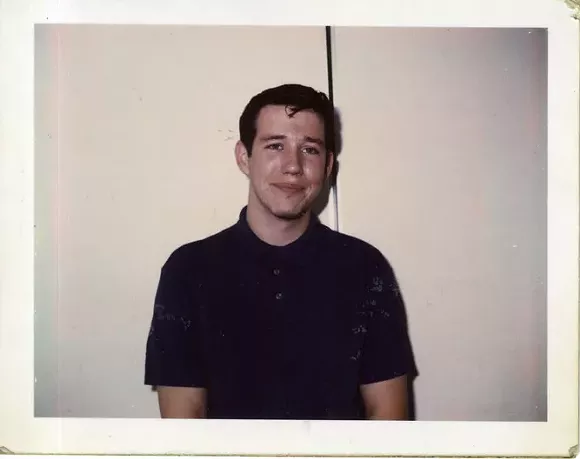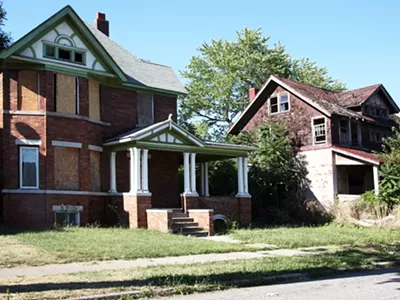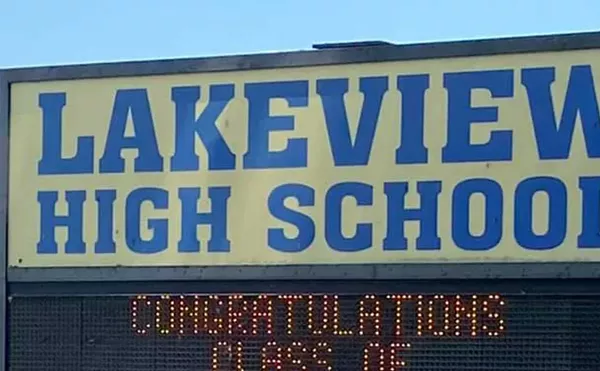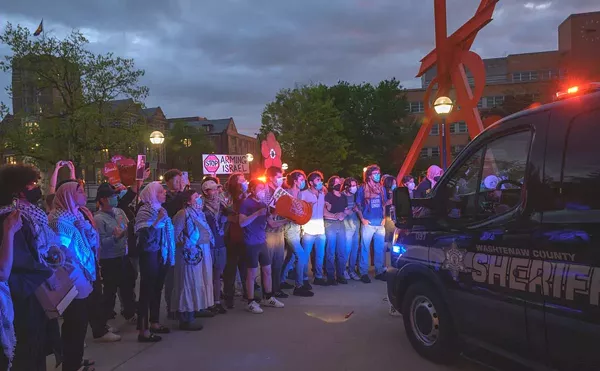The final flight of Martin McNally
The hijacker from Detroit left St. Louis with a fortune — but it all slipped from his grasp somewhere over Indiana

Audio By Carbonatix
[
{
"name": "GPT - Leaderboard - Inline - Content",
"component": "35519556",
"insertPoint": "5th",
"startingPoint": "3",
"requiredCountToDisplay": "3",
"maxInsertions": 100,
"adList": [
{
"adPreset": "LeaderboardInline"
}
]
}
]
Page 2 of 5

Beginning in the mid-1960s, the "Golden Age" of airline hijacking was an era when any passenger could walk through an airport terminal unmolested, breeze onto the tarmac, and board a plane — all that with their shoes on, no less. In some cases, you could even pay for your ticket on board.
This casual freedom — a relic of a more civilized time — persisted in the face of an unprecedented wave of hijackings. Early interventions proved laughably inadequate, which flabbergasted airline companies. Ticket agents were instructed to subjectively screen passengers based on a cooked-up checklist of psychological and physical traits believed to be particular to hijackers, and although sky marshals were deployed in 1970, their limited ranks couldn't hope to make a dent in the vast number of flights taking off each day in U.S. airports.
The virtually nonexistent security led to a frenzy of hijackings. According to Brendan Koerner's 2013 book chronicling the period, The Skies Belong to Us, more than 130 hijackings were committed in U.S. skies between 1968 and 1972.
Many of the culprits were straight nutjobs, driven by religious or political yearnings that required (for some reason or another) immediate passage to Cuba. But even as the capers escalated in audacity and potential violence, airlines companies balked at beefing up their own security. Instead, they sought to avoid the possibility of violence at all cost. Crews were instructed to comply with hijackers' demands rather than risk an altercation. Pilots on domestic flights were provided with charts outlining passage to Havana, just in case.
But there was a second, altogether different species of hijacker: not a nutjob, but rather a certain kind of foolhardy opportunist. In other words, a common crook.
Driving through Detroit in January 1972, McNally listened with growing interest to a radio news report of a two-month-old hijacking in the Pacific Northwest. Shortly before Thanksgiving, an unidentified man had commandeered a Boeing 727 after taking off from Portland International Airport.
According to the report, the hijacker had ordered the plane to land and subsequently demanded a parachute and $200,000. Upon receipt, the hostages were released, but the hijacker kept the crew and ordered the plane to take off once again. Forty-five minutes into flight, the man jumped from the lowered stairwell at the rear of plane. Both hijacker and cash had seemingly disappeared without a trace.
There was a different species of hijacker: not a nutjob, but a certain kind of foolhardy opportunist. In other words, a common crook.
tweet this
In the coming months, McNally would spend hours poring through library books on parachutes and skydiving. An idea took root in his mind. The hijacker on the radio — soon mythologized as "D.B. Cooper," who would inspire more than a dozen copycats — had demonstrated an effective strategy for air piracy, and it seemed a much easier task than knocking over an armored truck or a bank.
McNally was a product of a large family, and had lived most of his life in his hometown of Wyandotte. McNally's father, a shoe store owner and respected figure about town, had put eight children through Catholic school. But young Marty spurned his studies. Instead of completing 11th grade, he enlisted in the Navy, where he labored as an airplane electrician. It was no harbinger of destiny: His flight time was restricted to servicing the cramped patrol craft sweeping for Soviet submarines off the coast of Alaska.
Given a general discharge from the Navy in 1964, McNally had no interest in joining his father at the family shoe store. He wound up scrambling through a series of odd jobs and minor scams, including a plan to embezzle gas sales from a service station and a short-lived counterfeiting operation, which ended when he was busted feeding fake quarters to a laundromat change-machine. By 1972, he was exhausted with the paltry returns on minor scams.
One big score, that's what he needed. All he required was a weapon, some phony documents, and a passable disguise. D.B. Cooper had shown him the rest.
Getting the gun was easy. A local pool hall hustler, Walter Petlikowski, provided a .45 rifle, and McNally cut 10 inches off the barrel. The weapon fit comfortably inside a black attaché case with a wig and smoke bombs. Petlikowski, in turn, signed on as an accomplice in exchange for $50,000.
In the fall and winter of 1972, McNally charted a tour of Midwest cities, hitting Indianapolis, Chicago, St. Louis, and Kansas City. He settled on St. Louis' Lambert airport — it had the worst security, McNally says — and made two more trips to the airport with Petlikowski to prepare for the one-way flight.
On the morning of June 23, a Friday, Petlikowski dropped McNally at the main terminal. Petlikowski had changed his mind about participating in the hijacking directly, but he'd still agreed to act as chauffeur for half his original fee. McNally, briefcase in hand, bid his accomplice farewell and boarded Flight 119 destined for Tulsa, Okla.
McNally encountered no metal detectors on his way to the flight. His ticket, purchased with forged Navy discharge papers, identified him as "Robert Wilson."
Less than 30 minutes before landing in Tulsa, McNally excused himself from his seat three rows from the rear of the plane and walked to the lavatory. When he emerged, he was wearing a shaggy brown wig and sunglasses and wielding a rifle. He handed a note to a startled stewardess.
A few minutes later, the captain's voice came over the intercom:
"Ladies and gentleman. We have a passenger who needs to return to St. Louis."
McNally followed D.B. Cooper's example to the letter, though he added a key embellishment: McNally demanded more than twice Cooper's ransom, asking for $500,000. He also requested another $2,000 in small bills, most of which he gifted to the stewardesses as a tip for their compliance.
Around 4 p.m., Flight 119 returned to St. Louis and came to a stop on a runway on the far edge of the airfield. McNally made his demands known. He claimed to control the detonator to a bomb somewhere on the plane, and that any attempts at resistance would be met with gunfire.
Over the next hour, a flurry of negotiations and counter-negotiations played out between the hijacker — who relayed all messages to the cockpit via stewardesses — and FBI agents on the scene. Eventually, McNally permitted 80 hostages to leave the plane by way of the plane's inflatable emergency slide.
But raising a half-million dollars on a Friday evening was no easy task. It could take hours. So, after refueling, McNally directed Flight 119's crew and the 14 remaining hostages to ready themselves for takeoff. Back in the air, the plane traced circles above St. Louis. At one point, McNally allowed the pilot to redirect the plane to Fort Worth, Texas, based on reports that the money could be collected there much faster. That report turned out to be premature, and the plane instead turned back to St. Louis, where bank and airline officials were still scrambling to put together the ransom.
It was after 9 p.m. when their efforts succeeded. Flight 119 made its second landing on a Lambert runway. Now, McNally relayed three additional demands: He needed a shovel, flight goggles, five parachutes, and two harnesses.
The money was delivered in two packages: a heavy airmail bag and a small wrapped parcel. Despite his preparations, McNally struggled to figure out how to buckle the parachute harness. So he added an additional request: for someone to show him how to put the thing on.
When the "instructor" (actually an undercover FBI agent) came aboard, McNally watched from a distance of several feet, rifle at the ready in case of ambush. The instructor/FBI agent made no move to disarm McNally, and after his quick lesson, left the aircraft unharmed.
It was just after midnight, and the plan seemed to be chugging along perfectly. McNally released 13 more hostages, leaving under his control one hostage, two stewardesses, and the flight crew.
TV and radio stations were already broadcasting the unfolding drama across the country. From behind the rectangular glass facade of the main Lambert terminal, throngs of passengers watched as a tanker truck refueled Flight 119, readying the plane for its fourth St. Louis takeoff in the past eight hours.
But nothing could have prepared McNally for the interference of a young Florissant businessman, David Hanley, who was among the bystanders ogling the drama from the terminal.
As the jet taxied down the runway, its massive engines revving in preparation for takeoff, Hanley's 1971 Cadillac Eldorado crashed through the runway's perimeter, battering through a fence at 80 miles per hour on a collision course with Flight 119.
The plane, heavy with fuel, was essentially a bomb with wings. Over the intercom, the captain's voice crackled with panic. "Oh my god, there's a vehicle on the runway!"
Hanley steered the Cadillac into the nose of the plane. Inside, the impact knocked McNally forward in his seat, and the heavy vehicle careened through the nosewheel, coming to a smoldering halt against the landing gear beneath the portside wing. The damage was superficial — the jet fuel did not ignite — but the plane was crippled.
An ambulance arrived to take Hanley to a hospital. He had two broken jaws, broken ribs, a fractured skull, and a crushed left arm and ankle — but the only damage McNally cared about had been inflicted on his getaway ride. The aircraft was useless now. McNally relayed an urgent message to the cockpit: "Get me another plane."
It took 90 minutes to bring a second Boeing 727 alongside the disabled airliner. Fearful of FBI snipers, McNally pressed himself between two stewardesses and covered his head with his briefcase until he safely entered the new plane's lowered rear stairs.
The second plane was fueled and ready for takeoff. Along with his civilian hostage, McNally presided over the jet's three-man replacement crew as well as the one remaining stewardesses he'd kept from Flight 119. There was no need for more leverage than that. McNally ordered the plane to leave St. Louis and set a course to Toronto.
Tracing a straight line, the flight path would take the plane over the vicinity of Detroit. In the preceding months, McNally had tried to work out the precise timing of his jump based on the plane's airspeed, but he now worried that the delays had disrupted his calculations. He had originally planned to make his jump shortly after midnight. It was now nearly 4 a.m.
Still, it was time to leave. He stripped off his disguise and buckled the parachute's harness around his arms and legs.
McNally didn't know where he was. From 10,000 feet, the undisturbed whiteness of the clouds below had obliterated any landmark or geographic feature. He wondered if the pilot had betrayed him, and whether he was seeing not clouds but the deep waters of Lake Michigan.
In reality, McNally chose to make his jump too early. The plane was passing above central Indiana, about 150 miles southwest of Detroit.
Having already hijacked two planes that day, getting to the ground should have been the easy part of McNally's plan. He intended to bury the money immediately, leave the area, and lay low for a few weeks or months. Then he would return with a shovel.
McNally dropped from the rear stairwell. Without firing a shot, he'd just made more money than he'd ever earn in a lifetime of shoe sales or petty crime.
But riches were not in McNally's future. Gravity saw to that.





